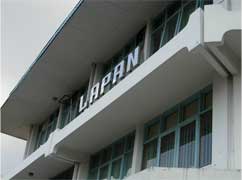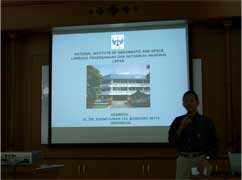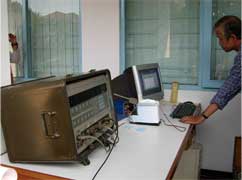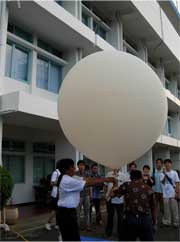京都大学21世紀COEプログラム 活地球圏の変動解明 アジア・オセアニアから世界への発信


目次
The 3rd KAGI21 International Summer School (the 3rd ISS) was held from July 16-28, 2006 at the Faculty of Earth Science and Mineral Technology (FIKTM) of Institut Teknologi Bandung (ITB). The 3rd ISS was organized by ITB and Kyoto University. On the first day of the 3rd ISS, there was an opening ceremony which started at 8:30am.
At the beginning of the opening ceremony, there was a report by a member of the Local Organizing Committee, Dr. Nanang T Puspito. Dr. Nanang gave thanks to the lecturers from Kyoto University and to the countries which sent many participants to the 3rd ISS. The second speech was made by the Dean of FIKTM-ITB, Prof. Sudarto Notosiswoyo, who also expressed his appreciation for the ISS, which has already been held twice at ITB.
The next program was an introduction of KAGI21 by its leader, Prof. Shigeo Yoden. He explained about the KAGI21 project which included the 3rd ISS program and also explained the importance of the equator area as a key place for global warming and weather forecasting. The objective of the KAGI21 project is to investigate the active geosphere and the area has many active places which need more investigations by geoscientists, from the geology (crusts, mantles, volcanoes etc.) to the atmosphere.
The last speech was made by Dr. Djoko Santoso, the Rector of ITB. He gave a talk about research cooperation between ITB and Kyoto University, and hoped that cooperation would be increased in the future. After his speech, the Rector hit a gong, a traditional music instrument which is usually used as an opening sign of a ceremony in Indonesia.
At the end of the opening ceremony, the Rector gave a special lecture about ‘4D Microgravity in Talang Jimar field, South Sumatra’. This research was carried out by injecting water into oil wells and then monitoring the gravity anomaly of the surfaces. The research was done three or four times a year at specific time intervals time, then all of the results were analysed together. The accuracy of microgravity in this research was 10 microgal.
(Sorja Koesuma)
人間活動の時間スケールで変動し、人と自然の共生をはかる上で重要な空間領域である「活地球圏」は、多重の時間空間スケールで複合的に生じている点に特徴があり、従来の地球科学諸分野の枠組みを超えたものである。本サマースクールでは、この活地球圏に対する多方面からのアプローチを参加者に紹介するため、他分野とのつながりを意識した講義が行なわれ、専門分野やバックグラウンドが違う参加者でも理解できるように、基本的な事柄から発展的な事柄まで幅広い内容が扱われた。
第1週目の講義で福田助教授は、測地学が地震学や気象学をはじめ、他分野とどのように関わっているかを説明され、地表や宇宙から重力や地殻変動を測定する方法及びその物理的な解釈について講義された。また、津田教授はGPSやラジオゾンデなど、リモートセンシングの方法の原理や、具体的な観測記録を図やグラフを用いながら分かりやすく講義された。これらの講義を通じて、活地球圏で起こっている現象を把握することの重要性を学ぶことができた。
Mori教授は地震時の記録から、地球の内部構造や地震の発生過程をどのように考えるかについて講義され、地震の被害の様子を記録した写真からは、そのスケールの大きさや、研究の成果を用いて被害を最小限に食い止めることの必要性を感じさせられた。余田教授は、流体力学の基本方程式から波の伝播や渦に関する講義をされ、固体地球科学だけでなく流体地球科学も、活地球圏を知る上で必要不可欠であることを学んだ。
また、昼休みには参加者によるポスター発表が行なわれ、ポスターのトピックに興味のある参加者同士が集まって、和やかに議論が行なわれていた。専門分野外の研究内容については、普段あまり目にすることがなかったので新鮮さを感じ、発表者に質問をすることでより自分の視野を広げることができた。
(由井 智志)
第2週目の講義は、余田教授、嶋本教授、淡路教授によって行なわれた。
余田教授の講義は、「地球温暖化と気候変動」というテーマで、オゾンの枯渇と地球温暖化の問題に焦点を当てて行なわれた。余田教授は、これらの問題についての経緯や現状、今後の展望に至るまでを、現象の発生メカニズムを絡めて解説してくださり、とても理解しやすいものであった。
嶋本教授は「断層と地震」というテーマで、岩石変形の基礎や断層の不安定性、摩擦溶融などの内容について講義してくださった。講義は、実際のフィールドで採取された岩石や、嶋本教授本人が行なわれている先駆的な岩石摩擦実験の結果などを踏まえて総合的に行なわれ、とても興味深く、かつ刺激的なものであった。
淡路教授の講義のテーマは「活地球圏:海洋循環と気候」であった。淡路教授は、データ同化や四次元変化(4D-VAR)などといった、海洋学において用いられる手法の解説や、それらを用いたエルニーニョ現象のシミュレーション結果などの紹介をしてくださった。特に、今回のような国際サマースクールという形は、エルニーニョ現象や地球温暖化などといった、国際規模で取り組まなければならない問題について考えるのに、とても良い機会になった。
また、バンドン工科大学(ITB)の講師陣による講演も行なわれ、ITBで行なわれている国際的な取り組みや研究計画などが紹介された。学生の私にとっては、普段あまり聞くことが出来ない内容も含まれており、とても有意義なものであった。
(野田 俊太)
サマースクール期間中、毎日の講義終了後に1時間程度、計算機実習の時間が設けられた。教材として「KAGI21計算機実験集 vol.1 地球流体力学入門」を使用した。この実験集は、地球流体力学の基礎を数学的に理解するとともに視覚的に体験できるように、本サマースクールのために開発されたソフトウェアである。線形移流拡散・非線形移流拡散・ブラウン運動・変形と回転・二次元渦・二次元渦糸系・静的安定度・重力波・対流・慣性不安定・ロスビー波・順圧不安定・地衡流調節・エクマン螺旋・カオスと予測可能性といったテーマについて、収録された数値実験を通して学ぶことができるようになっている。
この実習は、1週目に行われた余田教授の講義「地球流体力学入門(An Introduction to Geophysical Fluid Dynamics)」と連動しており、その日の講義内容に対応する実験集の解説書が配布された。解説書には、ソフトウェアの使い方とともに各テーマの理論的背景や練習問題も書かれており、講義中に余田教授による解説と実演も行われた。
1週目は、参加者を2つのグループに分け、それぞれのグループが1日おきに実習を行った。実習は講義室の向かいにある計算機室で行われた。実験集がインストールされた10数台のPCが用意されており、1人1台を使用し、各自課題に取り組んだ。この実験集ではマウスやキーボードによる入力でパラメータを自由に変えることができるので、物理現象のパラメータ依存性や数値計算の限界について、具体的な例にもとづいて視覚的に実感し学ぶことができた。疑問点のある者は、積極的に余田教授に質問し理解を深めていた。2週目は、希望者のみの自由参加であったが、熱心に課題に取り組む参加者の姿が見られた。
サマースクールの最後に、この計算機実験集のソフトウェアやドキュメントを収めたCD-ROMが参加者全員に配布された。参加者はこれを使って、今回の講義ではあまり詳しく触れられなかったテーマについても、今後じっくりと学ぶがことができるであろう。
(神代 剛)
There are some high in-land mountains and islands formed due to ancient volcanic activity in Korea, but I have not been able to see active volcanoes before this field trip. Thus I was excited even before leaving for the trip and it was a new experience in a great natural setting.
At first, we went up a mountain together and enjoyed the beautiful scenery of Bandung from the top of the mountain. We could see very steep cliffs which were formed by faulting. An expert on the Indonesian volcanoes kindly explained not only how the Sunda caldera system was formed but also the local legend (“upturned boat”) on the Tankuban Parahu volcano. It was a very nice day to do field work, and I inhaled fresh air and felt the cool wind. It was something interesting to feel cool in a place near the equator.
After observing some igneous rocks and taking photos together, we moved to the main field area where we could see a crater still emitting a strange smell. What a beautiful volcano we saw in front of us! The Tankuban Parahu strato-volcano occupies the central part of the large Sunda caldera. The last eruption of the volcano occurred in 1983. I heard the Indonesian people monitor the volcanic activity carefully and sometimes warn people to move to other places whenever the volcanic activity starts to increase. It seems that volcanic eruptions and large earthquakes are the two main natural disasters in Indonesia. We could feel several earthquakes even during the short period of the ISS. Compared to earthquakes, volcanic activity seems to be less dangerous, since a well-organized warning system can prevent people from being attacked by violent volcanic lava flow. All of the ISS participants must have been very interested in the volcano and were busy taking many photos. I was deeply fascinated by the spectacle.
The volcano now is one of the most popular places for visitors. In short, visiting the volcano was the one of the best activities of the 3rd ISS and will definitely be enjoyed by future participants.
(Han Raehee)
On August 26, all participants went to the Geological Museum in Bandung as one of the field training programs of the 3rd KAGI21 International Summer School(3rd ISS). After we arrived, we first saw a movie which explained the history of the museum and the geology in Indonesia. This movie was short but interesting, and after that, museum staff lead us to the rooms where a huge number of rock samples and fossils are conserved. It was very impressive to see such a large amount of rocks from the whole country.
After a brief discussion with the museum staff, we freely walked in the museum and looked at the exhibits with the 3rd ISS lecturers from Kyoto University. We were able to get to know that a lot of geological studies have been conducted in Indonesia, and also learned lots about Indonesian geodynamics, volcanoes and seismicity.
It was great because everybody was free to look at what is of his or her own interest, and ask questions to the museum staff or professors of Kyoto University (especially Dr. Shimamoto).
The museum is quite big and very well organized, and there are many posters which give information about various different topics. Although some of them are not written in English, we asked the Indonesian students about their contents and got good opportunities to talk with them. This training was globally interesting, and it was another good time to speak with lecturers, researchers and participants.
(Nicolas Brantut)
「活地球圏」、それは、長い地球史の諸変動のうち、特に人間活動の時間スケールで変動し、人と自然の共生をはかる上で重要な空間領域を示す新たな定義である。そして「活地球圏」で、多重の時間空間スケールで複合的に生じている変動現象を、フィールド研究からモデル研究まで融合し、新たな視点のもとに形成することを目指している。そこで、サマースクールでは、「活地球圏」の異なった分野の様々な知識を講義を通して得るだけでなく、いくつかのフィールド実習の機会も設けられていた。
その一つが、インドネシア宇宙庁(LAPAN)での実習であり、このLAPANでの実習は、サマースクールの第2週目に、午後の時間を使って行われた。この日までの講義において、私たち参加者は、ある程度の基礎知識を講義から得ていたので、充実した実習時間を過ごすことができたと思う。
実習ではまず、LAPANで行われている研究内容の説明を受けた。そしてそれにより、インドネシアの「活地球圏」研究に果たす役割の大きさを知ると同時に、通信技術の必要性や研究における観測のもつ重要性を、再認識することができた。それからその後は、3つのグループに分かれ、LAPANにおける実際のデータ取得の状況、GPS観測機器、ラジオゾンデ観測機器などの見学をした。自分の研究分野と異なる分野の観測装置に触れることができ、貴重な経験を得るとともに楽しい時間を過ごした。また、見学の最後には、実際に説明をしながらラジオゾンデに水素ガスを注入し空に放つという実習もあり、大変に貴重な経験となった。
(畑 真紀)
 写真1:LAPAN概観 |
 写真2:LAPANでの講義 |
 写真3:ゾンデ観測装置 |
 写真4:ゾンデ |